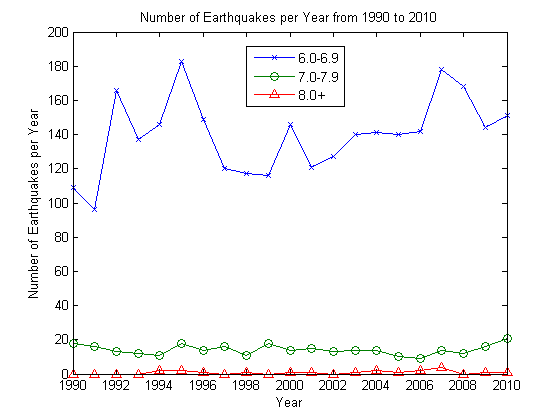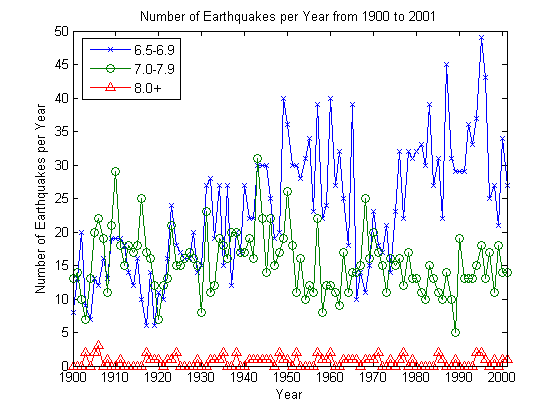Since the beginning of 2010, there have been many devastating earthquakes near large population centers. These earthquakes include a 7.0 in Haiti on Jan 12, 2010, an 8.8 in Chile and Feb 27, 2010, a 6.1 in Turkey on Mar 8, 2010, a 6.9 in Chile on Mar 11, 2010, a 6.9 in China on Apr 14, 2010, a 6.3 in New Zealand on Feb 21, 2011, a 9.0 in Japan on Mar 11, 2011 and a 7.1 in Japan on Apr 7, 2011. These earthquakes have had tragic consequences, especially in Haiti and Japan, where over 220,000 and 10,000 people have died, respectively. This surge of earthquakes in the news has caused many people to speculate about whether the number of earthquakes is increasing and the reasons why. We found data on earthquakes from 1900 to 2010 and will show whether there has been a recent rise in earthquakes or not.
Earthquakes are terrifying events which have plagued human beings since the beginning of civilization. For centuries, people thought that earthquakes were caused by underground air currents, humidity or underground water. When there is a perception that earthquakes are becoming more prevalent, theories abound as to what the cause is. For instance, some people believe that recent earthquakes are a sign of the End Times. Others believe that large earthquakes are the result of a government experiment called HAARP. There are also those who believe that the recent spat of earthquakes are either created or exacerbated by man-made causes, such as dams, large buildings, extraction of resources. Many scientists believe in man-made causes of earthquakes; however, a general concern about environmental destruction can cause people to attribute the wrong causes to some earthquakes.
Before we start trying to find the causes of recent large earthquakes, we should determine if there has actually been an unusual increase in seismic activity. Based on data from the USGS, I plotted the number major earthquakes from 1900 to 2001. I also plotted the number of earthquakes from 1990 to 2010, based on another set of data from the USGS.
 The centennial data set of earthquakes provided by the USGS has several restrictions that made a smooth plot of data from 1900 to 2010 impossible. The data set does not include earthquakes below a magnitude of 6.5 before 1964. Additionally, from 2002 to 2010, there is only data about the number of earthquakes in the different magnitude ranges (i.e. 6.0-6.9 and 7.0-7.9), whereas the previous data set was limited to 6.5. This is why the two graphs have different ranges of magnitudes covered.
The centennial data set of earthquakes provided by the USGS has several restrictions that made a smooth plot of data from 1900 to 2010 impossible. The data set does not include earthquakes below a magnitude of 6.5 before 1964. Additionally, from 2002 to 2010, there is only data about the number of earthquakes in the different magnitude ranges (i.e. 6.0-6.9 and 7.0-7.9), whereas the previous data set was limited to 6.5. This is why the two graphs have different ranges of magnitudes covered.
From 1900 to 2010, the frequency of earthquakes of magnitude 7.0 to 7.9 and those of 8.0 and above did not change substantially. From 1900 to 2001, there was an average of 23 earthquakes per year of magnitude 6.5 to 6.9. There was also an average 15.3 earthquakes of magnitude 7.0 to 7.9 and and average of 0.68 earthquakes of magnitude 8.0 and above per year. There was a standard deviation of 9.52, 4.74 and 0.76 on the numbers of earthquakes in magnitude ranges 6.5 to 6.9, 7.0 to 7.9 and 8.0+, respectively. From 1990 to 2010, there were 14.24 earthquakes per year in the range of 7.0 to 7.9, and 0.95 earthquakes per year of magnitude 8.0 and greater. The averages from the 1990s and 2000s are close to historical averages from the 20th century, so there was no substantial increase in large earthquakes over that period. In 2010, there were 21 earthquakes of magnitude 7.0 to 7.9 and one earthquake greater than magnitude 8.0. That year did experience more earthquakes of magnitude 7.0 to 7.9 than normal, but this number was not unprecedented. There were 12 years in the 20th century that experienced more than 20 earthquakes of magnitude 7.0 to 7.9, with the maximum of 31 in 1943. There was an increase in reported earthquakes in the range of 6.5 to 6.9 over the 20th century, but USGS attributes this to better monitoring. The data show that there is no evidence for an increase in the number of earthquakes in recent years.
The USGS has received many emails about a perceived increase in earthquakes and has taken the time to issue a statement regarding the issue. The USGS lists four reasons for the perception that earthquakes are increasing. The first reason is that there are many more earthquake monitoring stations now than in previous years, and they communicate more rapidly, which allows more earthquakes to be located. For instance, in 1931 there were 350 monitoring stations around the world, and now there are more than 4000 stations. The second reason is that there are more people in population centers that are prone to earthquakes, many of whom live in buildings that are not particularly earthquake resistant. This may cause the rising death tolls in recent years, as seen in Haiti. The third reason is that news about earthquakes arrives much faster now, so the global public is aware of earthquakes soon after they happen. Stories about earthquakes that happened within the past hour will be more interesting that earthquakes that happened several weeks ago, so the speed of information affects how prominent a news story about an earthquake is. The fourth reason is that when earthquakes cluster, people may sense that the frequency of earthquakes is rising. However, people generally don’t notice when few earthquakes happen. Clustered earthquakes can be independent, so there is no reason to believe that a spate of earthquakes implies that more earthquakes will happen or that a drought of earthquakes means than an earthquake will happen.
After reviewing the data from recent years, we can conclude that the number of large earthquakes is not increasing and is well within historical norms. There is no reason to believe that grand changes in the world are transpiring. However, as we can see in Japan, Haiti and Indonesia, earthquakes can be extremely dangerous. We should continually work on earthquake preparation and create buildings that can withstand large earthquakes. This advice is especially true in the developing world, where large populations are accumulating, often in areas not built to resist earthquakes.


HOLY S*** WE ARE ALL GOING TO DIE
Very great post. I just stumbled upon your blog and wished to mention that I have really loved browsing your weblog posts. In any case I will be subscribing for your feed and I am hoping you write once more very soon!
Hi,me again in my first comment i mean the earthquakes not earrhquakes …. Im sorry for the confusing miss spelled word. 🙂
Hi,me again in my first comment i mean the earthquakes not earrhquakes …. My apologe…. 🙂
Hi my name is crystal and im concerned about all thr earrhquakes going on this year in 2011,,,, so what im reallly trying to ask is why are so may earthequakes happening this year it seems like theres an earthquake every week…. We just had one a few miutes ago. Whats going on in the world?!?!?!?!!!!